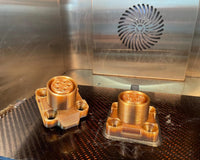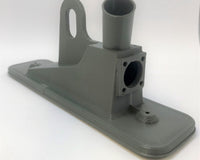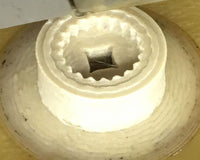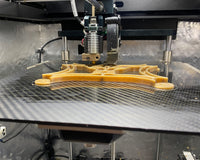Desktop 3D printers are mainly consumer or entry-level enterprise machines. They are usually made for prototyping and deskside use. Industrial 3D printers (Additive Manufacturing Machines) are used for manufacturing, usually in industrial settings. In Fused Deposition Modeling (FDM, also called FFF) a new category of high-temperature 3D printers is emerging which is fusing these formerly disparate groups of systems. These are high-temperature 3D Printers which are capable of manufacturing in high-performance engineering plastics such as PEEK and PEI.
What is a high-temperature 3D printer?
This category of machines is very new. There are many more people saying that they have a high-temperature machine than actually have one.
Essentially in order to be a high-temperature 3D printer:
- the bed temperature has to be a 150 C or above
- the ambient temperature has to be 150 C or above
- a sustained nozzle temperature of over 450 C has to be achievable
- Chamber temperatures should also be controllable and as constant as possible.
Simply having a nozzle capable of extruding at above 350 C is not enough. Materials such as the PEAK family are very difficult to process. PEI, PEEK, PEKK, PEK, PPSU and other similar high-performance plastics will not extrude properly without good chamber temperature control. For more information on how to properly 3D print PEEK and PEAKs you can see this post. For more information on how to 3D print PPSU check out this post.

A spool of PEEK filament.
Due to these materials being difficult to process just nozzle temperature will not give you properly crystalized and built parts. Your builds will fail if your chamber and temperatures are not well controlled. In addition to this High-temperature 3D printers often have higher grade components and materials than desktop 3D printers. This is partially because of the evelvated temperatures and also because of the applications that these printers are used for. Many high temperature 3D printers are used for manufacturing and so need higher tolerances and performance than desktop systems. High-temperature FDM printers are not a new phenomenon. Stratays has been selling its Fortus line of systems for a number of years now. What is new is that now there are around 15 vendors launching different high-temperature 3D printers to compete with them for manufacturing. Enterprise customers are also now manufacturing aerospace and other parts with high-temperature machines at scale also.
Why are high-temperature 3D printers important?
Desktop 3D printers are generally not used for critical applications and parts, high-temperature machines are. These machines are used in medical and aerospace applications for end-use parts. Actual drone, aircraft, rocket and Formula 1 car parts are made with these materials and machines. The tolerances, dimensional accuracy and properties of the parts are critical. If your Yoda fails who cares if an aircraft part fails a lot of people will care. These machines are on the forefront of using 3D printed parts in aerospace and other applications. 3D printed PEEK, PEKK, PPSU and PEI (Ultem) parts are replacing steel and other metal parts in mission-critical applications. 3D printed high-performance plastics are being used to save weight on next-generation aircraft, satellites, and rockets. High-Temperature 3D Printers are not hype but actual production machines.

PPSU 3D Printing filament.
What can a high-temperature 3D printer do?
Essentially they are 3D printers capable of coherently extruding semi crystalline high performance plastics such as PEAKs and PEI. PEAK is a family name for polymers such as PEKK and PEEK. PEAK (polyaryletherketone) materials include PEK (Polyetherketone), PEKK (Polyetherketoneketone), PEEK (Polyether ether ketone) and PEKEKK (polyetherketoneetherketoneketone). PEEK is the most famous of these materials and is often incorrectly used as the family name for all of them. High performance engineering plastics such as the amorphous PPSU and PEI can also be 3D printed on these machines. PEI (polytherimide) is also called Ultem (Sabic tradename). This amorphous material is FAA certified and often used onboard commercial or general aviation aircraft. There are many PEAK grades and some are used for implants in the body, others for aircraft and yet others for high performance engineering applications. PPSU (which is also called PPSF but is known as polyphenylsulfone) is a material that can be sterilized and put into an autoclave. Generally, there are lots of different grades for these materials. We'll make another post at one point on when to use which one.
What are engineering plastics?
Engineering plastics is not just some marketing mumbo-jumbo. In terms of plastics, we have standard (also called bulk) thermoplastics such as PP (polypropylene) and PS (polystyrene). A later generation of plastics is called engineering plastics. These engineering plastics have better mechanical and thermal qualities than bulk plastics. PA (polyamides) such as PA 6,6, PA 11 and PA 12 are tough and durable. These materials have also been engineered, blended and created and branded by polymer companies. Brands such as Rilsan and Zytel are used for these materials. Other examples of engineering plastics are POM (polyoxymethylene but better known as acetal) and PC (polycarbonate).

A spool of PEI (Ultem) filament.
What are High-performance plastics?
High-performance polymers are plastics that have better thermal or mechanical properties than engineering plastics. Generally speaking, these plastics are able to withstand operating temperatures of above 150 C. Some of these materials have excellent resistance to chemicals, acids and solvents. Where bulk plastics are cheap and are used for low-performance disposable things (plastic bags), engineering plastics are used for parts that need to perform for longer periods (car parts) and high-performance plastics are used for things that have to perform in very demanding conditions (aircraft, F1 cars). Where bulk plastics are cheap and shapeable into many things, engineering plastics can better withstand the world and high-performance plastics are built for critical applications. Our PEEK, PEEK CF, PEKK, PEI and PPSU materials are part of this group of plastics. And for these materials to 3D print properly you need a high-temperature 3D printer.
Why are high-performance plastics important?
Polymers are very light materials when compared to metals. Their continuous operating temperatures and strengths are also much lower than metals. What if you could make high-performance plastic parts that were as strong as metal parts but significantly lighter? Well if that were the case then your plan would fly faster or longer; your car would travel further on a tank of gas, your UPS shipment would be cheaper etc. Light weighting is seen as a niche thing. But, industry is the general making and lugging about of stuff. If all the stuff in the world becomes lighter everything changes. Making things lighter fundamentally changes the economics and viability of industries. A material such as PEEK or PEI (can in some cases) in a commercial aircraft replace a metal part, saving weight in the aeroplane. A more efficient plane that can fly a passenger cheaper from one place to the next can make an airline more competitive than those flying on the same route with older aircraft. So lighter planes with better seat miles power the commercial aircraft industry. If that part can then also be optimized through 3D printing, printed on demand without stock and have integrated new functionality in it then 3D printing high-performance plastics is a very interesting proposition. The more widespread use of high-performance plastics can make certain players in certain industries much more competitive than others. Deploying those polymers in a coherent, safe and cost-efficient way through 3D printing can be a big source of competitiveness.
Minnows Amidst Whales
The 3D printing industry itself is around $10 billion a year in revenues. Airbus has $66 billion a year in revenue. Boing has $94 billion. So if we only look at the commercial aviation industry then one small part of our industry can play a huge role in a far larger one. PEEK, PEI, PEKK and PPSU can also be used in other industrial applications and in space. Our PEEK, various PEI grades and Carbon PEEK are already being used in high-performance applications in aerospace. So we find ourselves as a teeny tiny company in Haarlem, a minnow amidst the whales.






